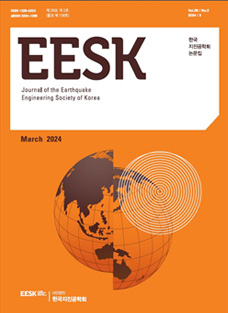1. 서 론
지진 발생 시 신속하고 정확한 지반운동 추정은 조기경보 발령 및 사후 피해 저감을 위해 필수적이다. 우리나라는 2015년도부터 규모 5.0 이상의 지진에 대해 지진조기경보(Earthquake Early Warning)발령 서비스를 시행하였다. 또한, 국내에 큰 피해를 입힌 경주 지진 및 포항 지진 이후 2017년부터는 발령 목표를 25초 이내로 단축하는 노력을 지속하고 있다. 현재 국내에는 지진 계측을 위하여 기상청, 한국지질자원연구원, 한국수자원공사, 한국농어촌공사, 한국원자력안전기술원 등 여러 기관이 약 700개소 이상의 지진 관측소를 운영 중이다[1]. 그러나 현재 존재하는 지진 관측소의 개수로는 관측망의 밀도가 충분하지 않아, 신속한 조기경보와 정확한 진도 추정에 한계가 있다.
이를 보완하기 위해, 다양한 물리량을 측정할 수 있는 MEMS(Micro Electro Mechanical Systems) 센서가 활용되고 있다. MEMS 센서는 가속도, 압력, 온도 등 다양한 물리량을 측정할 수 있으며, 소형화와 저전력 소비, 경제성 등의 장점을 가지고 있다. KMA에서는 구조물 내부에 설치된 다수의 가속도계 MEMS 센서를 활용하여 지진을 계측하고 있다[1]. MEMS 센서는 기존 지진 관측소에 설치된 지진계와 비교하여 계측 성능은 낮지만, 저렴한 가격으로 신속하고 간편한 설치가 가능하다. 따라서 MEMS 센서를 지진 관측소 공백 지역의 구조물에 설치한다면, 지진 관측망의 밀도를 효율적으로 증가시킬 수 있다. MEMS 센서는 2022년도 기준 전국에 약 6,700 개 이상이 설치되어 있다.
MEMS 센서는 유지보수 및 보안을 고려하여 각 구조물 내부에 설치되며, 주로 각 층의 벽면 콘센트 등 안정적인 전력 공급이 가능한 위치에 설치된다. Fig. 1은 MEMS 센서가 구조물 내부에 설치된 환경의 예시를 보여준다. 이러한 설치 특성으로 인해, 지진 발생 시 MEMS 센서의 계측 기록은 구조 물의 거동을 포함하게 된다. MEMS 센서에서 계측된 기록으로 지표면 기준의 지반운동을 확인하기 위해서는 구조물의 응답을 파악하고 이를 계측 데이터로부터 보정하는 작업이 필수적이다.
구조물 응답에 대한 연구는 다양한 방식으로 수행되어 왔다. Michel and Gueguen[2]은 프랑스 그르노블 시청 건물에 설치된 계측기를 활용하여 상시 미동 및 실제 지진 계측 기록을 기반으로 구조물의 고유 진동수, 감쇠 특성 및 상층부 응답의 증폭 현상을 분석하였다. Sinha and Choudhury[3]는 철근콘크리트 프레임 구조물에서 층간 변위와 층전단력 등 주요 응답 변수들의 동적 증폭 경향을 분석하였으며, 층수가 증가할수록 응답 증폭이 증가하는 경향을 확인하였다. 국내에서는 Oh and Kim[4]이 진동대 실험을 통해 장주기 지진동이 구조물 및 비구조 요소의 가속도 응답에 미치는 영향을 분석 하였다. 실험 결과, 장주기 지진동에 의해 상층부에서 특히 높은 증폭 현상이 나타나는 것으로 확인되었다. Jeon et al.[5]은 전력설비 케이블 종단부에 대한 가속도 증폭비 분석을 수행하였다. 다양한 재질의 부싱을 가진 구조물을 대상으로 3축 진동대 실험을 수행하여, 구조물 지지부와 케이블 종단부 각각의 가속도 증폭비를 산정하였다. 한편, 구조물-비구조요소 상호작용을 고려한 연구도 수행되었다. Bae et al.[6]은 구조물과 비구조 요소를 2자유도 시스템으로 모델링하여 동적 상호작용에 따른 가속도 증폭 특성을 분석하였으며, 지진 시 비구조 요소의 증폭계수가 구조물과 비구조요소 간 질량비 및 감쇠 특성에 따라 변화함을 확인하였다. Wang and Hutchinson[7]은 기록된 실제 건물 응답 데이터를 기반으로 비구조 요소에 작용하는 탄성 및 비탄성 가속도 증폭 특성을 정량화하였으며, 특히 구조물의 고유 주기와 연결된 모드 특성에 따라 증폭이 크게 달라지는 것을 확인하였다. 이러한 선행 연구들은 구조물 내 위치한 계측기록으로부터 지표면 기준의 지반운동을 추정하기 위해서는 구조물의 동적 특성에 따른 증폭을 제거할 필요가 있음을 나타낸다.
구조물 내의 각 층에서의 계측 기록으로부터 지표면 기준의 응답을 파악하기 위해서는 층별 지진파 증폭계수(Amplification Factor, AF)가 요구된다. 증폭계수는 경험적인 방법을 이용하여 지진 발생 이후 실제 계측 데이터를 바탕으로 산정할 수 있다. 그러나 지진 발생 이전에 구조물 응답을 사전에 예측하여 구조물별 증폭계수를 할당하는 연구는 아직 부족한 실정이다. 이번 연구에서는 다자유도계(Multi-Degree of Freedom, MDOF) 해석을 통해 증폭계수를 산정하여, MEMS 센서가 설치된 구조물에 대한 최대지반 가속도(Peak Ground Acceleration, PGA) 증폭모델를 개발하고자한다. 이 때 PGA는 지진조기경보를 위한 지표면 진도 계산 시 사용되는 주요 인자로, 개발된 PGA 증폭모델과 구조물의 수평최대층가속도(Peak Floor Acceleration, PFA)로부터 계산할 수 있다. 본 연구에서는 MDOF 해석을 위해 MEMS 센서가 설치된 각각의 구조물 정보를 수집하였으며, PGA 증폭모델의 검증을 위해 구조물 내에서 실제 지진을 계측한 가속도 센서 데이터들과의 비교분석을 진행하였다.
2. 활용데이터
2.1 구조물 정보
구조물의 응답은 구조물의 종류에 따라 차이가 존재한다. 구조물의 분류를 위한 인자는 구조물의 고유주기, 높이, 총 층수, 센서 설치 층수 및 구조물 종류 등이 있다. 본 연구에서는 MEMS 센서 설치 구조물의 종류를 파악하기 위해 건축물대장을 활용하였으며, 다음의 사이트로부터 정보 수집을 진행하였다.
스마트 국토정보 시스템의 경우 일반지도, 위성지도 및 건축물대장 정보까지 한꺼번에 확인할 수 있어 높은 활용성을 가진다. 건축물대장을 통해 파악한 데이터는 건축물명, 구조물 형태, 구조물 총 층수, 높이 등이다. 추가로 Google Earth Pro, Google Map 및 Kakao Map 등의 로드뷰 기능을 활용하여 건축물대장 정보와 실제 구조물의 구조물 총 층수를 상호 확인하였다. 총 6,768개의 건물 중, 구조물 분류를 위한 필요 정보가 건축물대장에 존재하는 5,813개 데이터에 대해서 분류를 진행하였다. 전체 구조물 형태는 크게 십 수가지로 이루어져 있었으나 전체 비율의 1% 이하를 차지하는 데이터는 이 외로 묶어 분류하였다. Fig. 2는 구조물의 종류 및 총 층수에 대한 통계치를 보여준다. 수집된 구조물의 주요 형태는 철근콘크리트구조(Concrete) 85.2%, 조적조구조(Masonry) 7.4% 및 철골구조(Steel frame) 6.7%로 나타났다. 구조물 총 층수의 빈도수 확인 시, 5층 이하의 저층 건물이 82%로 주를 이루고 있으며, 10층 이하의 건물이 전체의 대부분의 비율인 93%를 차지한다.
2.2 MDOF 해석 프로그램
다자유도(Multi-Degree of Freedom, MDOF) 시스템은 여러개 질량 점과 이들을 연결하는 강성을 갖는 구조로 구성되며, 각 질량점은 고유한 자유도를 가진다. 이는 일반적으로 고층 건물과 같은 구조물의 수평방향 동적 응답을 해석하기 위해 사용된다.
이번 연구에서는 분석을 위하여 SimCenter 에서 개발한 해석 프로그램인 MDOF를 사용하였다[11]. 해당 프로그램은 지진하중, 풍하중, 기타 일시적인 외력을 고려한 구조물의 동적응답을 계산할 수 있으며, 입력 지진파, 구조물의 총 층수, 각 층의 질량, 전체 높이, 강성 및 감쇠비 등을 입력값으로 요구한다. 또한 구조물의 전체 거동을 층간 질량이 집중되는 형태인 이상화된 전단건물 모델로 간략화하여 다자유도 건물의 해석을 수행하며, 두가지 이상화 가정은 다음과 같다.
이와 같은 가정을 통해 구조물은 선형전단건물 모델로 단순화되며, MDOF 시스템의 운동방정식은 다음과 같은 형태로 표현될 수 있다.
여기서, [M]은 질량행렬, [C]는 감쇠행렬, [K]는 강성행렬, u는 상대변위 벡터, 그리고 는 지반의 가속도 벡터를 나타낸다. Newmark-beta 시간 이력 해석[12]으로 이 운동방정식의 해를 구하였으며, 결과적으로 MDOF 시스템에서의 해를 계산하였다.
이번 연구에서는 MDOF 프로그램을 R 프로그래밍 언어를 기반으로 코드화하였으며[13], CSV 파일을 활용한 구조물 정보 입력 및 결과 분석이 가능한 사용자 맞춤형 분석 시스템을 구축하였다. 이를 통해 다수의 구조물에 대한 반복적인 해석이 가능하도록 하였다.
2.3 MDOF 입력지진파 선정
MDOF 해석에 활용된 지진파는 총 78개로, 모멘트 규모 4.6에서 7.62 범위에 해당하는 국내외 지진 기록을 대상으로 하였다. 국내 지진파는 기상 청(Korea Meteorological Administration, KMA)에서 모멘트 규모로 분석된 3건의 계측 기록을 활용하였으며, 국외 지진파는 미국 태평양연안 지진 공학 연구센터(Pacific Earthquake Engineering Research Center, PEER Center)로부터 10건의 기록를 선정하였다. 선정된 지진파의 세부 정보는 Table 1에 정리하였다. 지진파 데이터는 진앙거리 0~100 km 범위 내에서 고르게 분포하도록 선정하였으며, 실제 구조물에 주요 영향을 미치는 하중 조건을 고려하여 수평 성분만을 대상으로 분석을 수행하였다.
3. 일반구조물의 PGA 증폭모델
지진 하중에 대한 구조물의 동적 응답은 구조물의 강성, 질량 및 감쇠특성에 따라 결정되며, 이는 구조물의 고유진동수(Natural frequency, fn) 또는 고유주기(Natural period, Tn)와 밀접하게 연관되어 있다는 것을 뜻한다. 따라서 이번 연구에서는 일반화된 다양한 구조물의 동적 응답 특성을 고유주기를 중심으로 분석하는 것을 주요 목표로 설정하였다.
일반적으로 구조물의 크기, 형상, 재료, 층수 등은 모두 상이하며, 각각 고유한 동적 특성을 갖게 된다. 이번 연구에서는 다양한 구조물의 동적 응답 특성을 이상화하여 분석하고자, 특정한 형상과 치수를 갖는 단순화된 구조물 모델을 사용하였다. 구체적으로는 가로 10 m, 세로 10 m의 정방형 평면을 가지는 전단형 구조물로 가정하였으며(Fig. 3), 해당 모델을 기반으로 고유 주기를 일정 간격으로 변화시키며 해석을 수행하였다. 구조물의 고유주기는 다음의 관계식(식 (2))에 따라 질량(m)과 강성(k)에 의해 정의된다.
이러한 정의에 따라 고유주기를 조정하는 것은 곧 강성 또는 질량을 변경하는 것을 의미한다. 이번 연구에서는 구조물의 질량과 형상을 일정하게 유지하고 강성만을 조절하는 방법으로 고유주기를 변화시키며 분석을 진행하였다. 분석에 사용된 고유주기의 범위는 0.05초부터 1.5초까지로 설정하였으며, 총 21개 구간(0.05, 0.06, 0.07, 0.08, 0.09, 0.1, 0.15, 0.2, 0.3, 0.4, 0.5, 0.6, 0.7, 0.8, 0.9, 1, 1.1, 1.2, 1.3, 1.4, 1.5)을 대상으로 하였다. 이는 실제 구조물들이 가지는 고유주기 범위를 고려하여 설정된 값이다. 추가적으로, 2.1절에서 수집된 구조물 정보에 따르면 전체 구조물 중 약 85.2%가 철근콘크리트 구조이며, 총 층수 10층 이하의 건물이 약 93%를 차지하는 것으로 나타났다(Fig. 2). 이를 반영하여 본 연구의 이상화된 구조물 모델은 10층 이하 철근콘크리트 구조물을 기준으로 설정하였다. 구체적으로, 구조물의 층고는 층당 3 m, 슬래브는 철근콘크리트, 단위중량은 24 kN/m3로 설정하였다. 이로 인해 계산된 층당 중량은 72,000 kN이며, 모든 해석에서 동일하게 적용되었다. 이에 따라 구조물의 형상 및 단위중량은 일정하게 유지되며, 분석에서는 오직 고유주기만을 변수로 설정하였다.
이번 연구의 최종 목적은 구조물의 세부 형상이나 층별 단위중량 차이에 따른 응답을 분석하는 것이 아닌, 고유주기 변화에 따른 구조물 층별 PGA 증폭계수를 도출하는 데 있다. 따라서 각 고유주기에 대응하는 구조물의 세부적인 형상이나 설계 조건은 별도로 고려하지 않았다. 대신, 대표적인 구조물 형상을 기준으로 고유주기만을 조정하여 일반화된 PGA 증폭 특성을 반영하는 모델을 구축하고자 하였다.
3.1 구조물 강성
단층 구조물은 단자유도계(Single Degree of Freedom, SDOF) 시스템으로 이상화할 수 있으며, 이 경우 구조물의 강성(k)은 고유주기(Tn)와 전체 하중(W)을 통해 다음 식과 같이 계산할 수 있다(식 (3)).
그러나 다층 구조물은 다자유도계(MDOF) 시스템으로 분류되며, 동일한 질량과 강성을 갖더라도 단자유도계(SDOF) 시스템에 비해 고유주기가 상대적으로 길게 나타난다. 이에 따라 구조물의 강성이 달라질 수 있으며, MDOF 구조물의 보다 정확한 동적 해석을 위해서는 강성 값에 대한 보정이 필요하다. 이번 연구에서는 MDOF 해석을 통해 실제 구조물의 고유주기를 도출한 후, 이를 반영하여 구조물의 강성을 보정하는 방법을 적용하였다. 이에 따른 MDOF 구조물의 보정된 강성(kMDOF)은 다음과 같이 정의된다 (식 (4)).
여기서, c는 고유주기 보정계수로, 초기 설정한 고유주기와 실제 MDOF 해석 결과의 고유주기 차이를 반영하기 위해 도입된 값이다. 이번 연구에서는 다음과 같은 절차를 통해 각 구조물 층수에 따른 강성 보정계수를 도출하였다.
-
1) 초기 강성 계산
-
- 식 (3)을 이용하여 초기 설정된 각 층수에 따른 구조물의 고유주기(Tn1)와 총 무게(W)를기반으로 MDOF 해석을 수행하기 위한 초기 강성(k1)을 계산한다.
-
-
2) MDOF 해석을 통한 고유주기 도출
-
3) 고유주기 차이에 따른 수정 강성 계산
-
- 해석 결과로 도출된 MDOF 고유주기(Tn2)를 기반으로 식 (3)을 재적용하여 수정 강성(k2)을 계산한다.
-
-
4) 강성 비율을 통한 보정계수 계산
-
5) 보정계수 적용 및 고유주기 검증
-
- 보정계수(c)를 초기 강성 추정 식(식 (3))에 적용하여 보정된 강성(k3) 을 계산하고, 이를 통해 다시 MDOF 해석을 수행하여 보정된 고유주기(Tn3)를 도출한다.
-
- 초기 고유주기(Tn1)와 보정 고유주기(Tn3)가 일치하는지 검증하여 보정계수의 타당성을 확인한다.
-
위와 같은 보정계수 도출 과정에서 MDOF 해석 절차상 지진파 입력이 요구되지만, 식 (3)에 따라 해석에 사용된 지진파의 종류나 강도와는 무관하게 일정한 층수 별 보정계수가 도출된다. 각 층에 대해 계산된 고유주기 보정 계수(c)를 Table 2에 정리하였다.
3.2 감쇠비
구조물의 동적 응답에 있어 감쇠비는 진동 에너지 소산에 직접적인 영향을 미치는 변수로, MDOF 시스템에서의 해석 정확도를 결정하는 요소 중 하나이다. 이번 연구에서는 철근콘크리트 구조물의 감쇠비 설정을 위해 Yoon[14]에서 제안한 국내 구조물의 실측 기반 감쇠비 값을 참고하였다. 해당 연구에서는 국내 철근콘크리트 아파트 17개 동을 대상으로, 강풍 시 구조물에 발생하는 진동을 계측하여 고유진동수와 감쇠비를 실측 및 분석하였다. 연구 결과, 구조물의 방향에 따라 상이한 감쇠비가 도출되었으며, 구체적으로 장변 방향에서는 0.67~1.67%, 단변 방향에서는 0.82~2.08% 범위의 감쇠비가 확인되었다.
이번 연구에서는 구조물 응답 분석의 주요 관심 인자가 최대지반가속도(PGA) 및 최대층가속도(PFA)로, 모두 수평 방향 성분에 기인한다는 점을 기반으로 감쇠비를 설정하였다. 이에 따라, Yoon[14]에서의 강풍에 의한 수평 방향 감쇠비를 적용하는 것이 타당하다고 판단하였다. 특히, 강풍 하중과 지진 하중은 모두 구조물의 횡방향 진동을 유발하며, 이는 전단형 구조물에서 유사한 진동 모드가 발생한다는 점에서도 공통점을 가진다. 따라서, 이번 연구에서는 보수적 접근을 위해 Yoon[14]에서 제시된 감쇠비 중 최대값인 2%를 기본 감쇠비로 설정하였다. 또한, 감쇠비의 변화가 구조물의 증폭 계수에 미치는 영향을 평가하기 위해, 3% 및 4%의 추가 시나리오도 추가로 고려하여 총 세 가지 감쇠비 조건(2%, 3%, 4%)에 대한 평균적인 구조물 응답을 분석하였다.
3.3 PGA 증폭모델
구조물의 응답 증폭 특성을 정량적으로 분석하기 위하여, 본 연구에서는 PGA 증폭계수(PGA Amplification Factor, AFPGA)를 정의하였다. 본 연구에서 정의하는 증폭계수는 구조물의 동적 응답 특성을 반영하여 사전에 응답 증폭을 예측할 수 있도록 구성된 경험적 계수 모델이다. AFPGA는 지진으로 인한 구조물 각 층에서 발생하는 최대가속도(PFA)를 입력 지진파의 최대지반가속도(PGA)로 정규화한 값으로, 구조물의 동적 거동에 따른 응답 증폭 정도를 수치적으로 나타낸다. 해당 PGA 증폭계수는 다음과 같이 나타 낼 수 있다(식 (5)).
AFPGA는 지진파의 특성에 따라 영향을 받으며 이에 따라 다양한 양상을 나타낸다. 일반적으로는 실제 지진 이후에 계측된 응답 데이터를 바탕으로 경험적인 방법으로 증폭계수를 계산할 수 있다. 그러나 이번 연구의 목표는 지진이 발생하기 이전에 구조물 응답을 사전에 예측하고, MEMS 센서가 설치된 각각의 구조물에 대해 증폭계수를 미리 할당하는 것이다. 따라서, 입력 지진파와 무관한 구조물 고유 특성 인자만을 활용하여 AFPGA 를 예측하는 모델을 구축하고자 하였다. 이를 위해 다음 세가지 주요 인자를 입력 변수로 선정하였다.
-
1) 구조물 고유주기(Tn) : 구조물의 동적 특성을 대표하는 변수로 강성 및 입력 지진파의 주파수 성분과의 공진 가능성에 영향을 미친다.
-
2) 센서 설치 층수(Story of sensor insatalled, S) 대비 총 층수(Total Story, TS) 비율(S/TS): 센서가 설치된 층의 절대 위치 대신 전체 층 수에 대한 상대적 위치를 고려하여 정규화한 값이다.
-
3) 30 m 평균 전단파 속도(VS30) : 지반의 강성 및 감쇠 특성을 나타내며, 지진파의 증폭에 영향을 주고 구조물 응답에 간접적으로 작용한다.
실제 해석 결과, AFPGA는 VS30에 따라 패턴이 달라지는 모습을 나타냈는데, 이는 입력한 지진파 데이터의 특성이 지반의 VS30에 따라 달라지기 때문이다. 이에 따라, 이번 연구에서는 VS30을 다음과 같이 세 가지 구간으로 구분하였다.
-
1) VS30 < 400 m/s : Slow VS30
-
2) 400 m/s ≤ VS30 < 760 m/s : Medium VS30
-
3) VS30 ≥ 760 m/s : Fast VS30
이러한 구간 설정은 미국 지진저감 위험 프로그램(National Earthquake Hazards Reduction Program, NEHRP)의 지반분류 체계를 참고하였으며[15], 본 연구의 목적상 VS30 범위 별 지진기록의 개수 비율을 적절히 확보하기 위해 Slow VS30의 범위를 400 m/s 미만으로 조정하였다.
Fig. 4는 이번 연구에서 사용된 입력 지진파를 VS30 범위에 따라 분류하고, 각 그룹에 대한 5% 감쇠비 기준 응답스펙트럼 및 평균 응답스펙트럼을 도시한 결과이다.
이번 연구에서는 21개로 한정된 고유주기(Tn)와 구조물 내 상대 위치를 나타내는 S/TS 에 따라 AFPGA를 정량화하고자 하였다. 이를 위해 2.2절에서 기술한 바와 같이, MDOF 시스템을 기반으로 각 구조물의 동적응답 해석을 수행하였다. 해석 결과로부터 각 구조물 조건별, 즉 고유주기(Tn)와 센서 설치 층수 비율(S/TS)의 조합별로 다수의 PFA 데이터를 획득하였다. 이후, 획득한 층별 PFA를 입력 지진파의 PGA로 정규화하여 AFPGA 값을 계산하였으며, 각 [Tn, S/TS] 조합에 대해 산출된 AFPGA 분포의 중앙값을 대표값으로 설정하였다. 또한, 중앙값의 통계적 변동성을 정량화하기 위하여 부트스트랩(Bootstrap)기법을 적용하여 모델의 95% 신뢰구간(Confidence Interval, CI)를 산정하였다. 부트스트랩 기법은 주어진 표본에서 동일한 크기의 재표본을 무작위로 반복 추출하여 각 재표본에 대해 통계량을 계산하고, 이로부터 전체 분포를 형성하여 표준편차를 추정하는 비모수적(Nonparametric) 방법이다[16]. 본 연구에서는 충분한 수렴성과 안정성을 확보하기 위해 10,000회의 부트스트랩 반복을 수행하였다. 부트스트랩 방법은 데이터 분포가 비정규성을 가지는 경우에도 통계적 유효성을 유지할 수 있다.
이후 AFPGA 중앙값에 대해 공간 분포를 부드럽게 연결하고 전반적인 패턴을 도출하기 위하여 3차원 LOESS(LOcally Estimated Scatterplot Smoothing) 스무딩 기법을 적용하였다 [17,18]. LOESS 기법은 전체 데이터를 단일 함수 형태로 모델링하지 않고, 각 데이터 포인트의 근방에서 로컬 선형 회귀(Local linear regression)를 반복 수행함으로써 비선형적이고 복잡한 패턴을 부드럽게 추정할 수 있는 방법이다. LOESS의 주요 파라미터인 Span은 각 점에서 고려되는 국소 영역의 상대적 크기를 의미한다. Span이 작을수록 국소적인 곡률을 민감하게 반영하지만 과적합의 위험이 증가하며, Span이 클수록 곡선이 완만해지고 국소적 거동이 희석될 수 있다. 따라서 최적의 Span 값 설정은 데이터의 특성과 해석 목적에 따라 결정되어야 한다. 이번 연구에서 도출된 AFPG A 데이터는 MDOF 시스템의 해석 결과를 기반으로 한 값이며, 실측 데이터가 아닌 구조물의 물리적 응답 특성을 대표 하는 값이다. 이에 따라 데이터의 전반적인 추세뿐만 아니라 국소적 반응 변화를 함께 반영할 수 있는 스무딩이 요구된다.
이번 연구에서는 Span 값으로 0.05, 0.1, 0.2의 세 가지 후보를 설정하고, 이들을 비교 평가하여 최적 값을 결정하였다. Fig. 5는 각 VS30구간(Slow, Medium, Fast)별로 설정된 Tn 범위(0.05~1.5초)에 대해, 후보 Span 값을 활용한 LOESS 결과의 평균제곱근오차(Root Mean Square Error, RMSE)를 나타낸다. RMSE는 원본 AFPGA 의 중앙값과 스무딩된 값 간의 오차를 정량적으로 나타내며, 스무딩의 정확성를 평가하는 기준으로 활용되었다. Fig. 5의 결과를 종합적으로 분석하면, 전반적으로 Span = 0.05일 때 대부분의 조건에서 가장 낮은 RMSE를 기록하는 것으로 나타났다. 반면, Span 값이 커질수록 RMSE가 전반적으로 증가하는 경향을 보였다. 이는 Span이 작을수록 국소 곡률을 민감하게 반영하여, 원본 데이터와 유사한 스무딩 결과를 제공할 수 있기 때문이다. 그러나 지나치게 작은 Span 값은 LOESS의 본래 목적인 데이터의 전반적 경향을 나타내는 것과는 상충될 수 있다.
이러한 한계를 보완하기 위하여, RMSE가 평균적으로 크게 나타난 Tn 조건(0.1초, 0.2초, 0.4초)과 낮게 나타난 Tn 조건(0.05초, 0.5초, 1.5초)을 선정하여, 원본 AFPGA 와 LOESS-smooted AFPGA을 시각적으로 비교분석 하였다. Fig. 6은 RMSE가 높게 나타난 Tn에 대해 해석된 AFPGA 및 Span 별 스무딩 결과를 보여주며, Fig. 7은 낮은 RMSE를 나타낸 Tn에 대한 스무딩 결과를 보여준다. Fig. 6과 같이 RMSE가 높게 나타난 Tn 조건에서는 Span = 0.05로 스무딩한 곡선이 데이터의 세부적인 변동에 과도하게 반응하여, 지나치게 요동치는 곡선 형태를 보였다. 이러한 경향은 특히 Fast VS30 지반 조건에서 두드러지게 나타났으며, 이러한 경향은 RMSE가 낮게 나타난 Tn 조건(Fig. 7)에서도 유사하게 관찰되었다. 반면, Span = 0.2의 경우 스무딩 곡선이 전반적으로 완만한 형태를 보였으며, high-RMSE 조건에서는 응답을 과소평가하고, low-RMSE 조건에서는 과대평가하는 경향이 나타났다. 이러한 결과는 S/TS에 따라 급격한 변화가 발생하는 구간에서 국소적인 데이터 특성을 충분히 반영하지 못해 과도한 스무딩이 발생한 것으로 해석된다. 이에 비해, Span = 0.1을 적용한 결과는 두 조건 모두에서 Span = 0.05와 유사한 수준의 RMSE를 유지하면서도, 데이터의 전반적인 증폭 경향과 국소적 변동 특성을 안정적으로 반영하였다. 이에 따라 이번 연구에서는 Span = 0.1을 최적 파라미터로 채택하였다.
MDOF 해석 결과에서는 일부 구조물 조건에서 AFPGA 값이 100% 미만으로 나타나는 구간이 존재하였다. 이는 지표면의 최대지반가속도(PGA)보다 구조물 내부 특정 층에서 발생한 최대가속도(PFA)가 오히려 작아지는 현상을 의미한다. 이러한 현상은 주로 단주기(매우 작은 Tn) 및 작은 센서 설치 위치 비율(S/TS)을 가지는 조건에서 관찰되었다. 보수적인 실무 설계를 고려하여, 스무딩된 AFPGA가 100% 미만인 경우에는 100%로 하한값을 보정하는 후처리 작업을 수행하였다. 보정된 값을 바탕으로 APPENDIX Table A1에 세가지 지반 조건(VS30 범위: Slow VS30, Medium VS30, Fast VS30) 및 Tn, S/TS에 따른 AFPGA의 값을 정리하였다. 또한 MDOF 해석 후 각 VS30 범위에 따른 모델의 불확실성을 확인하기 위해, 도출된 AFPGA의 표준편차를 계산하였다. 스무딩 후 하한값이 보정된 데이터의 경우에 표준편차를 계산할 수 없기 때문에, 보정되지 않은 데이터를 대상으로 표준편차를 확인하였다. 이를 APPENDIX Table A2에 나타냈다. Fig. 8은 PGA 증폭 모델을 기반으로 각 VS30 구간별 3차원 스무딩된 AFPGA분포를 시각화한 결과이다. 전반적으로 건물 상층부(높은 S/TS)로 갈수록 AFPGA 값이 커지는 경향이 나타났으며, 단단한 지반(VS30이 큰 경우)일수록 고주파 성분에 민감하게 반응하는 양상이 관찰되었다.
한편, 최적 Span을 적용하여 스무딩한 경우에도 일부 특정 조건—특히 Fast VS30 지반에서의 Tn = 0.05초, 0.1초, 0.4초—에서는 LOESS 곡선과 MDOF 해석 결과 간의 차이가 비교적으로 크게 나타났다(Figs. 6, 7). 이는 이번 연구에서 구축한 LOESS 모델이 단순한 2차원 평면 상 스무딩이 아닌, Tn, S/TS 및 AFPGA의 세 변수에 대한 3차원 회귀 모델이기 때문으로 해석된다. 즉, 특정 Tn 값을 고정하고 2차원 단면으로 시각화할 경우, 3차원 곡면의 형태나 데이터 분포 밀도 차이에 따라 스무딩 곡선과 원본 데이터 간의 오차가 발생할 수 있다. 특히 Fast VS30 지반 조건에서는 고주파 성분에 민감하고 PGA 증폭모델의 기울기가 급격하게 변화하는 특성으로 인해, 2차원 상에서의 스무딩 결과가 원본 AFPGA 값을 일부 구간에서 추종하지 못한 결과가 나타났다.
4. PGA 증폭모델과 구조물 응답 데이터의 비교분석
4.1 관측 데이터 수집 및 전처리
PGA 증폭모델의 검증을 위해 Center for Engineering Strong Motion Data(CESMD)에서 제공하는 실제 구조물 응답 데이터를 활용하였다. CESMD는 미국 지질조사국(United States Geological Survey, USGS)과 캘리포니아 지질조사국(California Geological Survey, CGS)이 공동으로 운영하는 데이터 통합 플랫폼으로, 미국을 포함한 여러 국가에서 발생한 지진에 대한 지진 기록을 제공한다[19,20]. CESMD는 강진기록 통합 프로그램(Strong Motion Virtual Data Center, VDC)과 공학 응용 중심의 데이터 검색 포털(Engineering Data Center, EDC)로 구성되어 있으며, 지반 운동 및 구조물 응답 데이터를 동시에 제공하는 오픈 액세스 시스템이다. 제공되는 데이터에는 가속도 시간 이력, 응답 스펙트럼, Fourier 스펙트럼, 스케일되지 않은 원시 데이터(Raw data), 위치정보 및 관측소 메타데이터(구조물 유형, 층수, 재료, 사용연도 등)가 포함되어 있다. 구조물 응답 데이터는 센서 설치 위치(층수), 방향(X, Y, Z), 설치 부위(지붕, 기초 등)에 대한 정보와 함께 제공된다.
이번 연구에서는 다음과 같은 조건을 설정하여 EDC 포털에서 데이터를 수집하였다: 관측소 유형 = Building(건물), 구조 재료 = Any(모든 항목), 지진 규모 = 3.5-8, 진앙거리 = 0–100 km. 추가적으로, 수집된 데이터 중에서 목조(Wood)건물로 분류된 경우, 구조물 정보가 결측된 경우, 지하층에서 계측된 센서 데이터는 분석 대상에서 제외시켰다. 최종적으로 총 25개 건물에 대한 50개의 지진이 수집되었으며, 311개 센서가 계측한 총 1,032개의 지진파 데이터가 확보되었다. Fig. 9는 수집된 지진파의 진앙거리 (Epicentral Distance)와 규모(Magnitude) 분포를 나타낸다. 활용된 관측 데이터에는 Local Magnitude(ML)와 Moment Magnitude(MW)가 혼합되어 포함되어 있으며, 대부분의 지진은 규모 3에서 6 사이의 중규모 범주에 해당한다. ML과 MW는 정의 및 산정 방식에서 차이를 가지지만, 이번 연구의 데이터 같은 중규모 영역에서는 두 규모 간의 체계적인 차이가 크지 않으며, 선형적인 상관관계를 보인다[21,22]. 이에 따라 이번 연구에서는 ML과 MW 를 구분하지 않고 하나의 통합된 규모 지표로 간주하여 분석에 활용하였다.
수집된 CESMD 데이터는 PGA 증폭모델과의 비교 분석을 위해 추가적인 전처리 과정을 거쳤다. CESMD에서 제공되는 구조물 응답 데이터는 동일 건물 내 복수 층과 각 층에 설치된 다수의 센서로부터 계측된 다중 채널 형태로 구성되어 있어, 하나의 지진 이벤트에 대해 여러 센서의 기록이 존재한다. 이번 연구에서는 이러한 계측 데이터를 통합 처리하여, 건물의 각 층별 대표 PFA를 산정하였다. 동일한 층에 복수의 센서가 설치된 경우, 설치 방향이 일치하는 센서의 PFA를 우선적으로 산술평균하여 해당 방향의 대표 응답으로 간주하였다. 이후, 서로 다른 방향에 설치된 센서들의 산술평균된 PFA는 벡터 성분으로 간주하고, 이에 대한 기하평균을 적용하여 해당 층의 대표 응답을 도출하였다. 이러한 과정을 통해 초기의 1,032개 개별 센서 데이터는 총 314개의 층별 대표 응답 데이터셋으로 통합 정리되었다.
추가적으로, MDOF 해석 모델의 구조적특성을 고려하여 센서 설치 위치에 대한 보정이 수행되었다. MDOF 모델은 각 질량이 각 층의 천장 슬래브에 집중되어 있다고 가정하는데, 이는 하나의 층을 바닥과 천장 사이의 단일 질량층으로 모델링하는 방식이다. 반면, CESMD 데이터에서 제공되는 센서의 설치 층수는 대부분 실제 건물의 바닥에 설치된 경우가 많아, 이와 같은 MDOF 모델과의 비교를 위한 보정이 필요하다. 이번 연구에서는 CESMD에서 제공된 센서 설치 층수를 기준으로, 이를 하나 낮춘 층(즉, 설치 층수-1)을 해당 응답의 실제 작용 위치로 간주하였다. 예를 들어, 센서가 2층에 설치된 경우 해당 응답은 1층 슬래브 상에 작용하는 것으로 해석하였다. 이에 따라 센서가 1층 및 Ground(지상층)에 설치된 경우, 측정된 PFA는 지상에서 계측된 PGA로 간주하여 각 구조물의 증폭계수를 계산하였다.
4.2 PGA 증폭모델 검증
이번 절에서는 앞서 제시한 PGA 증폭모델의 타당성을 검토하기 위해 CESMD에서 수집한 실측 구조물 응답 데이터를 기반으로 비교 분석을 수행하였다. 각 구조물의 고유주기(Tn)는 CESMD에서 제공하는 건물 높이 정보를 기반으로, 다음 식과 같이 미국 건축 구조기준인 ASCE 7-16에서 제안하는 경험식(식 (6))을 통해 추정하였다[23].
여기서, Ct와 x는 구조물 유형에 따른 계수이며, hn는 구조물 총 높이(m)를 의미한다. 이번 연구에서는 다양한 형태의 구조물이 포함된 CESMD 데이터의 특성을 고려하여, 모든 건물 유형에 적용 가능한 계수인 Ct = 0.0488, x = 0.75를 적용하였다. 계산된 고유주기 값을 기준으로, 전체 구조물을 주기 특성에 따라 다음과 같은 세 개의 범위로 분류하였다: 단주기 구조물(Tn ≤ 0.3 s), 중주기 구조물(0.3 < Tn ≤ 0.8 s) 및 장주기 구조물(Tn > 0.8 s). 그 후, 각 범주 내에서 구조물이 위치한 지반 조건에 따라 VS30 값으로 세분화하였다. 분석에 포함된 CESMD 구조물 중 단주기 및 중주기 구조물은 모두 Slow VS30 지반 조건에 포함되었고, 장주기 구조물은 Slow VS30 및 Medium VS30 범주에 존재하였다. 각 범주 내 구조물들의 평균 Tn을 산정하고, 이를 기반으로 이번 연구에서 구축한 PGA 증폭모델의 곡선을 도출하였다. 평균 Tn이 모델에서 정의된 Tn과 일치하지 않을 경우, 모델의 AFPGA는 선형 보간을 통해 추정하였다.
Fig. 10은 각 평균 Tn 범주별로 추정된 PGA 증폭모델과 CESMD 실측 데이터를 함께 도시한 결과를 나타낸다. 검정색 선은 이번 연구의 PGA 증폭 모델을 나타내며, ±1 표준편차를 함께 도시하였다. 또한, 각 S/TS구간에서 CESMD 구조물 응답 데이터가 5개 이상 존재하는 경우, 실측 데이터의 95% 신뢰구간을 함께 표기하여 응답 분포를 제시하였다. 각 도표의 좌하단에는 해당 주기 범주의 평균 Tn값이 명시되어 있다. 분석 결과, CESMD 데이터는 평균적으로 본 연구의 PGA 증폭모델 곡선보다 낮은 값을 나타내는 경향을 보였다. 이는 구조물의 실제 동적 거동이 이번 연구에서 이상화한 선형 구조물 모델과 다르기 때문으로 해석된다. PGA 증폭모델은 직육면체 대칭 구조물에 대한 선형 해석을 기반으로 구성되었으나, CESMD에 포함된 구조물들은 다양한 재료, 비대칭 구성 및 비정형 형상 등의 복합적인 특성을 내포하고 있다. 특히, 강한 지진 하중을 받은 구조물의 경우에는 비선형 거동이 발생할 수 있으며, 이에 따라 구조물의 강성이 저하되고 고유주기가 증가하게 된다. 이러한 고유주기의 증가는 구조물 응답(PFA)의 감소를 야기할 수 있다. 또한 비선형 거동으로 인한 에너지 소산 효과는 지진 에너지를 일부 흡수함으로써 가속도 증폭을 감소시키는 원인이 될 수 있다. 결과적으로, CESMD 실측 데이터가 PGA 증폭모델에 비해 낮은 응답을 나타내는 것은 실제 구조물의 비선형 거동과 다양한 물리적 특성을 반영한 합리적인 결과로 판단된다. 따라서 이번 연구에서 제시한 PGA 증폭모델은 선형 이상화 모델에 기반한 보수적 접근으로 해석할 수 있다. 또한, 실측 데이터와의 유사한 증폭 경향성을 유지함으로써 모델의 활용 가능성을 확인할 수 있다.
5. 결 론
이번 연구에서는 지진관측소 공백지역 구조물에 설치된 MEMS 센서를 활용하여 실시간 지진 감시 및 진도 추정을 가능하게 하기 위한 방안으로, 구조물 고유주기에 따른 PGA 증폭모델을 개발하였다. 구조물의 동적 응답을 다자유도계(MDOF) 시스템으로 간주하고, 구조물 특성과 지반 특성에 따라 최대층가속도(PFA) 응답을 예측할 수 있는 모델을 구축하였으며, 실측 지진 데이터를 통해 모델의 타당성을 검증하였다. 주요 결과는 다음과 같다.
-
1) PGA 증폭계수(AFPGA)는 구조물 내 각 층에서 계측된 PFA를 지표면 기준 PGA와 비교한 비율로 정의하였다. 주요 영향 변수로는 구조물 고유주기(Tn), 센서 설치 위치 비율(S/TS), 30 m 평균 전단파 속도(VS30) 를 선정하였다. 이 세 가지 변수를 기반으로 LOESS 스무딩 기법을 적용하여, VS30 각 구간별 PGA 증폭모델을 구축하였다.
-
2) 총 78개의 지진파(국내 지진 3건, 해외 지진 10건)를 활용하여 MDOF 해석을 수행하였다. 구조물의 형상과 단위중량은 일정하게 유지한 채, 고유주기를 세분화하여 강성을 조정하는 방식을 적용하였다. 해석 결과로 얻어진 AFPGA와 함께 부트스트랩(Bootstrap) 기법을 이용하여 중앙값 의 95% 신뢰구간를 산정하고, 데이터 분포를 확인하였다. 스무딩 파라미터(Span)는 0.05, 0.1, 0.2로 비교하였으며, Span = 0.1이 평균적으로 RMSE가 작고 데이터의 전반적 경향과 국소 변화를 균형있게 반영할 수 있어 최적값으로 채택되었다. 또한, 스무딩 후 AFPGA 가 100% 미만으로 나타나는 경우에는 실무적 보수성을 고려하여 100%로 값을 보정하였다.
-
3) 제안된 PGA 증폭모델의 타당성을 검증하기 위해, CESMD 데이터베이스로부터 총 1,032개의 구조물 응답 데이터를 수집하였다. 구조물은 고유주기에 따라 단주기, 중주기, 장주기 범주로 분류하고, 각 VS30 구간 별로 세분화하여 모델과 비교하였다. 비교 결과, CESMD 데이터는 평균적으로 모델 예측값보다 낮은 증폭을 나타냈으며, 이는 실제 구조물의 비대칭성, 비선형 거동, 감쇠 특성 차이 등에 기인하는 것으로 판단된다. 이번 연구의 모델은 직육면체 대칭구조 및 선형 MDOF 해석을 기반으로 한 보수적 모델이지만, 실측 데이터와 유사한 증폭 경향을 유지하여 모델의 활용 가능성을 확보하였다.
이번 연구에서 제안한 PGA 증폭모델의 적용으로, 지진 발생 이전에도 지진관측소 공백지역에 설치된 MEMS 센서를 통해 구조물의 응답을 예측 할 수 있다. 이를 통해, 실시간 지진 감시 시스템의 보조 관측망으로서 MEMS 센서가 활용될 수 있다. 다만 이번 연구는 구조때물의 비선형 거동 및 비대칭 구조 형상을 고려하지 않았으므로, 향후 비선형 MDOF 해석 및 구조물 유형별 특성을 반영한 PGA 증폭모델에 대한 추가 연구가 필요할 것으로 고려된다.






















